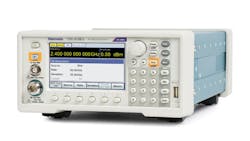Vector signal generators are test signal sources essential for evaluating modern communications systems and their components, with their many forms of modulation. The new TSG4100A series of vector signal generators from Tektronix includes three models with frequency coverage of DC to 2 GHz (model TSG4102A), DC to 4 GHz (model TSG4104A), and DC to 6 GHz (model TSG4106A). In addition, these test signal sources can produce all the latest forms of analog and digital modulation needed to keep pace with modern wired and wireless communications systems.
This file type includes high resolution graphics and schematics when applicable.
All three vector signal generators (see figure) are suitable for high-frequency measurements on components and systems when teamed with the firm’s analysis instruments—specifically, its model RSA306 USB spectrum analyzer and its line of high-speed oscilloscopes. The signal generators provide quite respectable performance at entry-level prices, with spectrally pure output signals under high-speed control.
All three models include a front-panel BNC connector port with access to output signals from DC to 62.5 MHz for low-frequency testing. These low-frequency signals feature amplitude accuracy of ±0.7 dB with typical harmonic levels of better than -40 dBc and typical spurious levels of better than -65 dBc.
Higher-frequency signals are available on all models at an N-type coaxial connector, with frequency tuning to 1-μHz resolution and better than 8 ms switching speed to within 1 ppm of a tuned frequency. All three signal sources provide signals with dynamic range of -110 to +16.5 dBm. For output levels from -100 to +10 dBm, the amplitude accuracy is ±0.45 dB through 2 GHz, ±0.6 dB through 4 GHz, and ±0.75 dB through 6 GHz.
The generators allow signal phase to be set with 0.01-deg. resolution from DC to 100 MHz, 0.1-deg. resolution from 100 MHz to 1 GHz, and 1-deg. resolution from 1 to 6 GHz. Output signals are relatively clean, with maximum single-sideband (SSB) phase noise of -106 dBc/Hz offset 10 kHz from a 1-GHz carrier and -120 dBc/Hz offset 1 MHz from a 1-GHz carrier for all three generator models.
All three models are equipped with analog modulation capabilities for amplitude modulation (AM), frequency modulation (FM), pulse modulation, and phase modulation. As options, they can be equipped for more advanced vector and digital modulation capabilities, including in-phase/quadrature (I/Q) vector modulation. One option allows the use of external I/Q modulation signals to RF bandwidths of 400 MHz for the 2-, 4-, and 6-GHz signal-generator models. These external inputs support I/Q modulation bandwidths of better than 200 MHz at less than 2.5 GHz and better than 150 MHz for carrier frequencies of 2.5 GHz and greater
As examples of the analog modulation capabilities, all three signal generators command phase modulation across a range of 0 to 360 deg., with better than 3% phase deviation accuracy for all carrier frequencies and modulation bandwidths as wide as 500 kHz. All three sources support pulse modulation at on-off ratios of better than 57 dB through 1 GHz, better than 40 dB through 4 GHz, and better than 35 dB through 6 GHz. The typical pulse rise/fall time is 20 ns.
Standard signal generator models are equipped with an oven-controlled crystal oscillator (OCXO) frequency reference for increased frequency stability. The OCXO time base features better than ±0.02 ppm frequency accuracy at calibration after a 20-minute warm up time. All three signal generators include GPIB, USB 2.0, Ethernet (LAN), and ES-232 interface connectors. P&A: $7300 and up; stock.
Tektronix, Inc., 14200 SW Karl Braun Dr., P.O. Box 500, Beaverton, OR 97077; (877) 977-0425
This file type includes high resolution graphics and schematics when applicable.
About the Author
Jack Browne
Technical Contributor
Jack Browne, Technical Contributor, has worked in technical publishing for over 30 years. He managed the content and production of three technical journals while at the American Institute of Physics, including Medical Physics and the Journal of Vacuum Science & Technology. He has been a Publisher and Editor for Penton Media, started the firm’s Wireless Symposium & Exhibition trade show in 1993, and currently serves as Technical Contributor for that company's Microwaves & RF magazine. Browne, who holds a BS in Mathematics from City College of New York and BA degrees in English and Philosophy from Fordham University, is a member of the IEEE.

